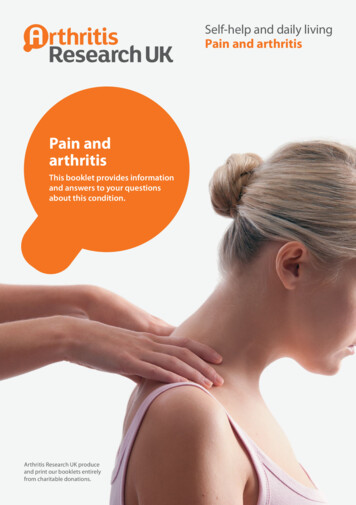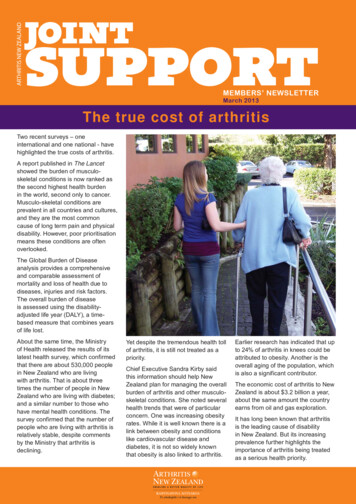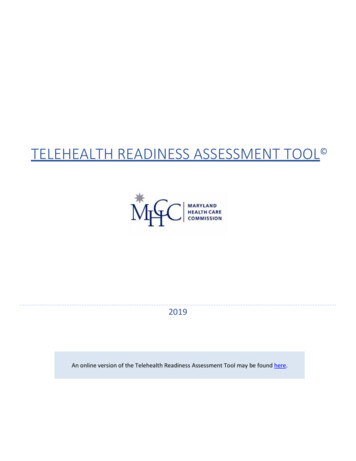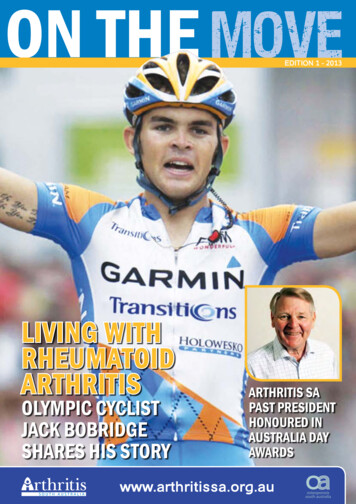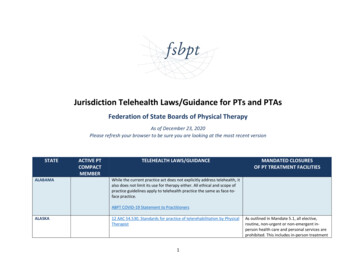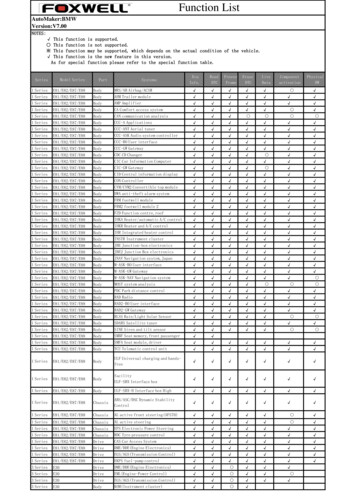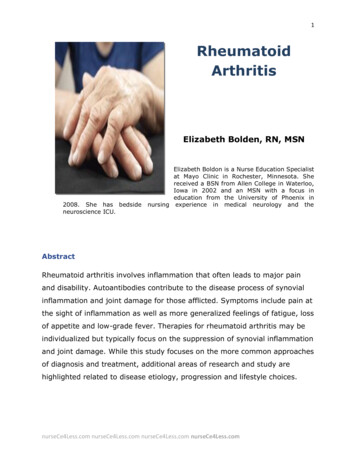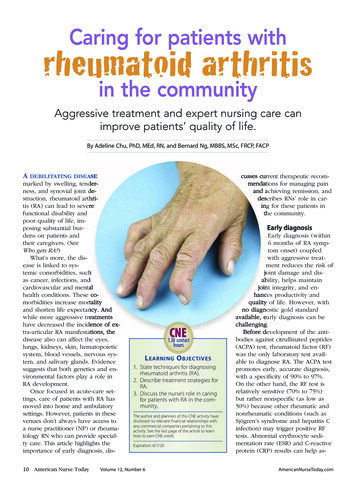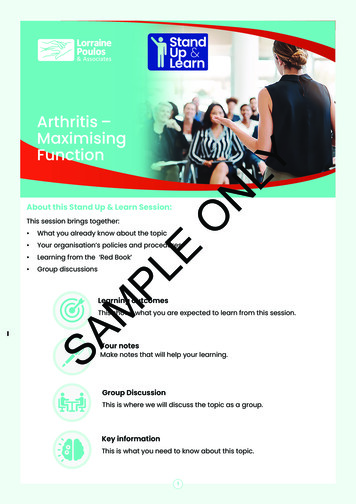
Transcription
StandUp g& TelehealthFunctionOAbout this Stand Up & Learn Session:This session brings together:What you already know about the topic Your organisation’s policies and procedures Learning from the ‘Red Book’ Group discussionsMPLE Learning outcomesSAThis shows what you are expected to learn from this session.Your notesMake notes that will help your learning.Group DiscussionThis is where we will discuss the topic as a group.Key informationThis is what you need to know about this topic.1
StandUp &LearnArthritis – Maximising FunctionMapping of the session to the relevant StandardsThe following module may assist as evidence to demonstrate theorganisation’s ability to support the Aged Care Quality Standards:Standards: 2, 3 and also linked to: 1, 4, 7 and 8Aged CareQuality StandardsStandard 1Consumer outcomeeoicsud ig nity a ndStandard 3Consumer outcomeI get personal care, clinical care,or both personal care and clinicalcare, that is safe and right for me.da andily suliv pping ortsStandard 4I get the services and supportsfor daily living that are importantfor my health and well-being andthat enable me to do the thingsI want to do.OcoOrganisation’s serviceenvironmentStandard 5I am a partner in ongoingassessment and planning thathelps me get the care and servicesI need for my health and well-being.Consumer outcomesicerv orSe fmplaintsStandard 2LYOCo ndanI feel safe and am encouragedand supported to give feedbackand make complaints. I am engagedin processes to address my feedbackand complaints, and appropriateaction is taken.erkacdbFeeStandard 6Consumer outcomemchStandard 7I get quality care and services whenI need them from people who areknowledgeable, capable and caring.Consumer outcomereonal caPers linical carecandConsumer outcomeHuman ResourcesI am confident the organisation iswell run. I can partner in improvingthe delivery of care and services.sStandard 8Consumer outcomeOngoiplanni ng assng w esith smeco nns t aum nderancevernl gonatioasianrgNagedcarequality.gov.auI am treated with dignity andrespect, and can maintain myidentity. I can make informedchoices about my care and services,and live the life I choose.MPLI feel I belong and I am safe andcomfortable in the organisation’sservice environment.EConsumer outcomeSAThe following module may assistas evidence to demonstrate theorganisation’s ability to support theNDIS Practice Standards and QualityIndicators.NDIS Practice StandardsNDIS Practice Standards andQuality IndicatorsJanuary 2020Version 32
Arthritis – Maximising FunctionStandUp &LearnLearning OutcomesAt the end of this session, you should be able to:Give a brief description of what arthritis is Describe signs of arthritis you may observe in your clientsProvide examples of the support strategies that could assist a client witharthritisDescribe how you would support a safe environment for a person witharthritis Describe what you would report and document about arthritisNLY Describe anything you know about arthritis. For example types of arthritis,signs and symptoms, treatments, how arthritis affects a person’s lifeexperience.E OConsider what you already know about arthritisSAMPLGroup discussion based on the Red Book: A Practical Handbookfor Basic Clinical Care in the Home. What support may clients with arthritis need?How would you provide a safe environment for clients with arthritis?What may you see or observe in a client with arthritis?When would you report arthritis-related changes to your supervisor?3
Arthritis – Maximising FunctionKey information about Arthritis?Arthritis is a name for a group of conditions affecting the joints. Theseconditions cause damage to the joints, usually resulting in pain andstiffness. Arthritis can affect many different parts of the joint and nearlyevery joint in the body.What are the different types of arthritis?LYThere are over 100 forms of arthritis. Each type of arthritis affects you andyour joints in different ways. Some forms of arthritis can also involve otherparts of the body such as the eyes. The most common forms of arthritisare: Osteoarthritis - Affects the whole joint i.e. knee, back, hips etc. Gout- Inflammatory and painful form of arthritis, usually in one joint at atime Ankylosing spondylitis - Inflammatory form of arthritis that affects thespineEONRheumatoid arthritis - Chronic inflammatory disorder of the immunesystemWhat are the signs and symptoms of arthritis?painstiffness or reduced movement of a jointswelling in a jointredness and warmth in a jointSA MPLArthritis affects people in different ways. The most common symptomsare:general symptoms, such as tiredness, weight loss or feeling unwell.Reference: ain/4StandUp &Learn
Arthritis – Maximising FunctionStandUp &LearnCheckyourlearning Give a brief description of what you have learned about arthritisDescribe the signs of arthritis that you may observe in clientsLY ONProvide examples of support strategies that could assist your clients witharthritis MPLEDescribe how you would support a safe environment for a person living witharthritisSA Describe how you would report and document observations about a personliving with arthritis5
Arthritis – Maximising FunctionStandUp &LearnThe following section should be read in conjunction with: A Practical Handbookfor Basic Clinical Care in the Home.Know your client: Check the care plan for abilities and limitationsUnderstand the impact of arthritis on day to day activitiesMonitor the use of pain medicationEncourage use of aids (jar openers, handrails, key holders etc.)NUndertake massage therapies as per care planOEncourage regular strengthening exercises as part of your visitMonitor footwear (not too tight, Velcro straps)Position furniture to support safe turning/rotationsEImprove lighting where possibleCheck mobility aids are in good condition ( eg: wheels, handles )Check their neighbourhood for mobility friendly accessMPL LYMonitor and support wellness:Observe:Reduced functionSA Reluctance to move aroundIncreased stiffnessSigns of redness and swellingGroup discussion on reporting changes and documentation:Discuss when you should contact your supervisor: Skin tears or reports of fallingPain or mood changesDecreased range of motionRedness around jointsRefusal/relunctant to mobilise6
Arthritis – Maximising FunctionStandUp &LearnCase Study: Scenario Based on the scenario below, write down youranswers to the following questions.A client that you regularly visit, has mentioned to you that they are havingdifficulties opening jars and packaging at times. You notice that the client’sfinger joints look red and bigger than you remember seeing them before. What would you be able to observe about the client?How could you support the client?N LYWhat would you report and document about this?MPL EOSA Should you contact your supervisior about this? Why or Why not?References A Practical Handbook for Basic Clinical Care in the Home: Lorraine Poulos &Associates (2017) Arthritis Australiahttps://arthritisaustralia.com.au/ Arthritis Carehttps://arthritiscare.com.au/7
Some forms of arthritis can also involve other parts of the body such as the eyes. The most common forms of arthritis are: Osteoarthritis - Affects the whole joint i.e. knee, back, hips etc. Rheumatoid arthritis - Chronic inflammatory disorder of the immune system Gout- Inflammatory and painf
